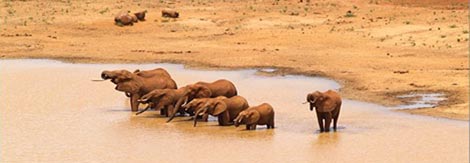Tsavo History
Tsavo National Park (East and West) was created in 1948. At approximately 21,000km², it is the largest protected area in Kenya. This National Park occupies half of the entire Tsavo region that the elephant population utilizes. Kenya banned legal trophy hunting in 1977. Before this ban there were numerous elephant-ivory hunting blocks surrounding the Tsavo National Park. Many of the largest tusks in Kenya were taken from Tsavo elephants.
Elephants
In the late 1960s, there were approximately 35,000 elephants in the Tsavo region. This population has suffered two population crashes.
The first was the drought in the early 1970s when an estimated 6,000 individuals died and over the next 4 years with low rainfall and lack of vegetation weakened females and young elephants died. Unlike pregnant females, females nursing a calf or young calves, independent bulls were able to travel greater distances in search of vegetation and their mortality was lower.
The second crash was due to the illegal killing of elephants for their tusks. The large bulls who survived the drought were the first victims for their large and heavy tusks. When the remaining bulls were difficult to find, the large females were targeted (their calves died as a results) and then whole families. By the late 1980s, at the height of the ivory poaching era, about 6,200 elephants remained in the entire Tsavo region.
Elephant Range
Aerial surveys conducted in the mid-1960 and 1970s showed that the majority of the groups sighted were confined within the National Parks. With the onset of the rains these groups dispersed, but there was little indication of large scale migrations. Elephant seasonal range was influenced to some extent by the surrounding legal hunting areas, rainfall and the development of artificial water resources within the National Park.
